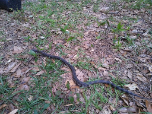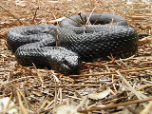Black Pine Snake (Pituophis melanoleucus lodingi)
Description: Adults average from 48 to 64 inches. The record is 89 inches. A large stocky snake. Back and belly are uniform (or nearly so) black or dark brown. Faint blotches may be seen on the hindbody or tail. Basically a very dark brown to black snake both above and below. Many examples do have a light chin. The black pine snakes east of Mobile Bay, AL are intergrades, with the Florida pine snake. The ground color of these is lighter than that of the more westerly snakes and the dorsal pattern of darker blotches is easily seen.
Habitat: Black pine snakes are endemic to the upland longleaf pine forests that once covered the southeastern United States. Habitat consists of sandy, well-drained soils with an overstory of longleaf pine, a fire-suppressed mid-story, and dense herbaceous ground cover. Duran found that radio-tracked black pine snakes usually were on well-drained, sandy-loam soils on hilltops, ridges, and toward the tops of slopes. They were rarely found in riparian areas, hardwood forests, or closed canopy conditions. More than half of the time, snakes were underground, usually in the trunks or root channels of rotting pine stumps. In Mississippi, each of five hibernating black pine snakes was in a shallow chamber formed by the decay and burning of pine stumps and roots. Available data indicate that black pine snakes rarely use the burrows of gopher tortoises
Range: The seldom black pine snake you find in a small area in eastern Louisiana, southeastern Mississippi, in the southern Alabama and the most northernwestern of Florida. Natural intergrades with the florida pine snake are known from the border area Florida/Alabama. Other subspecies distributions are not reached.
Found in these States:
AL |
MS
Diet: In habitat this Pituophis mainly feed upon several sorts of rodents up to the size of halfgrown rabits. Some individuals prefere ground sqirrels for food.
Reproduction: Aprox. 6 to 8 weeks after the mating the females deposit a clutch of 4 to 8 eggs in the size of hen eggs at a suitable place. After hatch the black pine snakes have a lenght of 40 to more than 50 cm. The coloration of the hatchlings can be lack black or black/black-brown with sometimes a whitish or rusty brown rest of patterns on the side. In some populations the rest patterns of the lodingi are so intensive, that the hatchlings can be confused with small northern pine snakes. At the end of its first year the rest pattern vanish more and more and most of the animals become black.
Status: This subspecies occupies a small fragmented range in southern Alabama and Mississippi; only one robust population exists (De Soto National Forest/Camp Shelby). It has been extirpated from Louisiana and some formerly inhabited Mississippi counties. Most of its historical longleaf pine habitat has been lost as a result of conversion to incompatible uses, principally commercial forestry, agriculture, and urban development. Vehicular mortality on roads further eliminates individuals.
»» Kingdom: Animalia - Animals
»» Phylum: Chordata - Chordates
»» Subphylum: Vertebrata - Vertebrates
»» Class: Reptilia - Reptiles
»» Order: Squamata - Scaled Reptiles
»» Suborder: Serpentes
»» Superfamily: Colubroidea
»» Family: Colubridae - Colubrids
»» Genus: Pituophis
»» Species: Pituophis melanoleucus - Pine Snake
»» Subspecies: Pituophis melanoleucus lodingi - Black Pine Snake
This article uses material from the Wikipedia article "Pituophis melanoleucus", which is released under the Creative Commons Attribution-Share-Alike License 3.0. Content may have been omitted from the original, but no content has been changed or extended.
|













